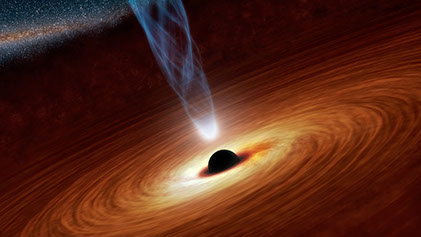Black Holes
Definition - Black Holes are by definition a black mass that has an escape velocity equal to or greater than the speed of light (3 x 10 m/s) at the event horizon
Information
8
Black Hole Size Comparison
A size comparison chart displaying the size relationship of different types of black holes
Miniature
Stellar
Supermassive
What is a black hole?

Stellar
Supermassive
Formed by the collapse of a large to massive star
Mathematically speaking miniature black holes are possible
Most common type of black hole
The largest type of black hole
Incredibly small in size
Event horizon can have a diameter as small as an atomic partial
Often formed after a supernova or going into the "giant" phase
Extreme gravitational pull
Mass is equivalent to billions of suns
Speculated to have formed at the beginning of our universe
Speculated to have formed as a byproduct of galaxy formation
Often at the center of galaxy's
Types of Black Holes
Miniature
Have never been observed
Black Holes by definition are a black mass that has an escape velocity greater than or equal to the speed of light (3 x 10^8 m/s) at the event horizon, which the theoretical boundary around a black hole were nothing can escape the gravitational pull. This means black holes have an incredibly high mass and density creating an unbelievably high gravitational pull that nothing can escape, not even light. Black holes have a gravitational pull so strong they are capable of devouring entire solar systems or galaxies.
Discovery
The idea of a black hole was first developed in 1916 by astronomer Karl Schwarzschild. Schwarzschild did this by using Einstein's theory of general relativity. The astronomer developed the Schwarzchild radius which is known as Rs = 2MG/c^2 which gives the maximum radius of a body with a specific mass that would not allow light to escape it's gravitational pull.
Black holes do not emit any detectable light, the main process involved in discovering a black holes existence is measuring visible light, X-rays and radio waves emitted by the surrounding material. For example, if a star is orbiting a black hole, the gravitational force of the black hole will pull the star's outer gases toward the black holes center. Since a star emits light, the process of a star being engulfed by a black hole is seen and from this is how a black hole is discovered.
http://upload.wikimedia.org/wikipedia/commons/8/89/PIA16695-BlackHole-Corona-20130227.jpg
Formed by the collapse of most massive stars
Image - Black Hole
© 2014 All Rights Reserved | Robert Miller | Terms of Service | Suggestions/Feedback
Theories
About
Site Information
What is Space
Image - Ice Planet
Image - Red Star
Image - White Star
Discover - Black Hole
Discover - Star
Live Video Feeds